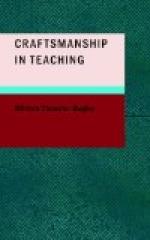To-day we are attempting to detect these sources of waste in technique. The problems of habit building or memorizing are already well on the way to solution. Careful tests have shown the value of doing memory work in a certain definite way—learning by unit wholes rather than by fragments, for example. Experiments have been conducted to determine the best length of time to give to drill processes, such as spelling, and penmanship, and the fundamental tables of arithmetic. It is already clearly demonstrated that brief periods of intense concentration are more economical than longer periods during which the monotony of repetition fags the mind to a point where it can no longer work effectively. We are also beginning to see from these tests, that a systematic method of attacking such a problem as the memorizing of the tables will do much to save time and promote efficiency. We are finding that it is extremely profitable to instruct children in the technique of learning,—to start them out in the right way by careful example, so that much of the time and energy that was formerly dissipated, may now be conserved.
And there is a suggestion, also, that in the average school, the vast possibilities of the child’s latent energy are only imperfectly realized. A friend of mine stumbled accidentally upon this fact by introducing a new method of grading. He divided his pupils into three groups or streams. The group that progressed the fastest was made up of those who averaged 85 per cent and over in their work. A middle group averaged between 75 per cent and 85 per cent in their work, and a third, slow group was made up of those who averaged below 75 per cent. At the end of the first month, he found that a certain proportion of his pupils, who had formerly hovered around the passing grade of 70, began to forge ahead. Many of them easily went into the fastest stream, but they were still satisfied with the minimum standing for that group. In other words, whether we like to admit it or not, most men and women and boys and girls are content with the passing grades, both in school and in life. So common is the phenomenon that we think of the matter fatalistically. But supply a stimulus, raise the standard, and you will find some of these individuals forging up to the next level.
Professor James’s doctrine of latent energies bids fair to furnish the solution of a vast number of perplexing educational problems. Certain it is that our pupils of to-day are not overburdened with work. They are sometimes irritated by too many tasks, sometimes dulled by dead routine, sometimes exhilarated to the point of mental ennui by spectacular appeals to immediate interest. But they are seldom overworked, or even worked to within a healthful degree of the fatigue point.




